Was für ein Heimauftakt! Satte vier Tore gab es für den FCSP am Millerntor lange Zeit nicht mehr. Das Ergebnis, besonders die zwischenzeitliche 4-0-Führung, mag nach einer dominanten Angelegenheit klingen. War es aber nicht. Vielmehr kann sich der FCSP bei seiner eigenen Effizienz bedanken. Trotzdem gab es abermals viel Gutes auf dem Platz zu sehen, wenngleich auch noch einige Baustellen vorhanden sind.
(Hier geht es „nur“ um Fußball. Zum Drumherum lest gerne den Text von Maik.)
Kein Daschner, kein Buballa, keine Dreierkette
Im Vorbericht hatte ich mit Lukas Daschner und Daniel Buballa in der Startelf gerechnet. Beide fehlten jedoch. Daniel Buballa fehlte wegen einer leichten Verletzung aus dem Spiel gegen Bochum (so die Erklärung von Timo Schultz in der PK nach dem Spiel). Auf der offensiven Halbposition, die ich Lukas Daschner zugerechnet hatte, spielte für mich etwas überraschend Rodrigo Zalazar (der mich auf dieser Position auch nicht überzeugt hat – muss er aber auch nicht, er soll Spiele gewinnen und das hat er getan…), während Benatelli und Knoll die Doppel-Sechs bildeten.
Beim Bochum-Spiel hatte ich es noch als Dreier-Kette benannt. Dies ziehe ich nun zurück und benenne die Formation des FCSP als fast klassisches 4-4-2 gegen den Ball, allerdings weiterhin mit Merkmalen einer Fünferkette, da Dittgen und Paqarada auf links ihre Rollen häufig genug offensiver interpretieren als Wieckhoff und Ohlsson auf der anderen Seite.
Umschalten folgt Umschalten folgt Umschalten folgt Umschalten…
Auch erwähnt hatte ich im Vorbericht, dass beide Teams nach Ballgewinn meist schnellstmöglich vertikal nach vorne spielen. Dabei nahmen beide Teams in Kauf, dass der Ball auch recht schnell wieder weg war. Ich habe mir das Spiel in Ruhe angeschaut und in meinen Notizen taucht der erste aus kontrolliertem Spielaufbau herausgespielte Torschuss beider Teams in der 55. Minute (!!!) auf. Das bedeutet, dass die 10 Torschüsse der Heidenheimer und die drei Tore des FCSP davor allesamt aus anderen Situationen entstanden sind (Umschaltmomente, 2.Bälle, Standards). Das ist selbst für ein Spiel zweier Teams, die mit Fokus auf das eigene Umschaltspiel agieren durchaus bemerkenswert, lag aber vor allem daran, dass beide sehr gut das Aufbauspiel des anderen störten bzw. das eigene Aufbauspiel noch verbessert werden kann. Grundsätzlich hatte tatsächlich der FCSP aus meiner Sicht die besseren Szenen bei eigenem Spielaufbau, welche jedoch nie in einem Torschuss mündeten. Schauen wir uns beide Teams im Spielaufbau mal genauer an:
Spielaufbau Heidenheim 1. Halbzeit
Der 1. FC Heidenheim hatte erheblich mehr Ballbesitz am Ende des Spiels aufzuweisen (knapp 63%). Das könnte auf eine Art Dominanz im Spiel hindeuten, welche auch zeitweise vorhanden war. Allerdings war es doch größtenteils eher ein Ausdruck des nicht sonderlich früh einsetzenden Pressings des FCSP.
Bei Ballbesitz Heidenheim passierte meist einiges an Veränderungen im ursprünglichen 4-4-2: Die Außenverteidiger (Föhrenbach auf links und der wirklich starke Busch auf rechts) schoben ganz nach vorne. Die beiden offensiven Mittelfeldspieler Pick und Schnatterer sich tiefer fallen ließen (war ja klar, dass Schnatterer von Beginn an spielte, wo ich doch bereits ankündigte, dass er aktuell eine eher untergeordnete Rolle in Heidenheim spielt – er blieb aber allgemein ziemlich blass). Zusätzlich verließ Kerschbaumer seine Position im zentral defensiven Mittelfeld und besetzte die Position links von den beiden Innenverteidigern, sodass eine Dreierkette im Aufbau entstand (erst dadurch konnten die beiden Außenverteidiger so weit hochschieben). Die perfekte Ausführung dieses Positionsspiels von Kerschbaumer machte übrigens einen gewissen Toni Kroos zu einem der Meister seines Fachs.
Der FCSP stellte sich in einem 4-4-2 dagegen. Zalazar und Kyereh hielten dabei Sechser Geipl zwischen sich und nahmen ihn damit größtenteils aus dem Spiel. Die komplexesten Rollen hatten Dittgen und Wieckhoff zu meistern, da sie immer wieder die fallenden Pick und Schnatterer anlaufen mussten. Ansonsten stand das 4-4-2 des FCSP absolut stabil gegen das Aufbauspiel von Heidenheim. Wirklich gefährlich konnte der FCH nur dann werden, wenn es gelang Geipl im Zentrum freizuspielen, sodass dieser aufdrehen konnte. Es blieb die gesamte 1. Halbzeit bei viel Ballbesitz für Heidenheim mit jedoch recht wenig Ertrag. Vermutlich deshalb wurde zur 2. Halbzeit umgestellt (später mehr dazu).
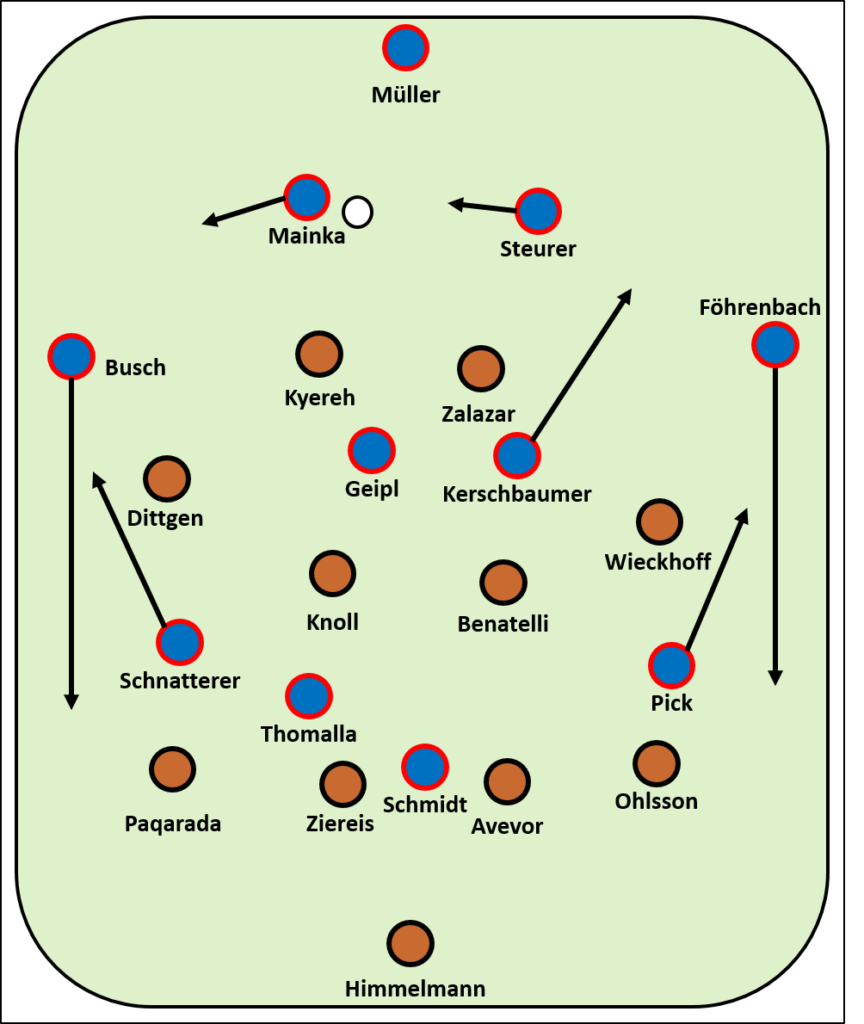
Spielaufbau FCSP
Der FCSP agierte grundsätzlich, trotz weit höherem Pressing von Heidenheim als sie selbst es taten, wieder mit mutigem flachen Aufbauspiel. Hierbei war Rico Benatelli einer der Taktgeber und ließ sich teilweise auch zwischen die beiden Innenverteidiger fallen. Das weite Aufrücken der Außenverteidiger, welches in Testspielen vielfach maßgeblich im Spielaufbau war, wurde nun gar nicht mehr genutzt. Vielmehr rückten Dittgen und seltener Wieckhoff in die vorderste Reihe und nur ab und an ließen sie sich aus dieser Position fallen.
Auch wurde wieder einmal das Ungleichgewicht des FCSP-Spiels deutlich: Denn während Jannes Wieckhoff sehr viel häufiger nicht ganz in vorderster Reihe zu finden war und daher auch Ohlsson nicht weiter hochschob, tat dies Dittgen umso mehr und sorgte auch dafür, dass Leart Paqarada den freien Raum vor ihm besetzte. Das führt dann dazu, dass Paqarada und Wieckhoff auf gleicher Höhe agierten, obwohl sie unterschiedliche Positionen bekleideten (und mich daraus auch mal eine Dreierkette mit Flügelverteidigern basteln ließen).
Ich hatte ja bereits geschrieben, dass ich den Spielaufbau des FCSP als etwas gelungener beschreiben würde. Das lag vor allem daran, dass in der 1. Halbzeit mehr als einmal das Spiel über die rechte Außenbahn schön entwickelt wurde. Und in diesen Situationen wurde auch klar, warum Wieckhoff eben nicht so weit hochschob: Er braucht noch Raum vor sich, damit er sein Tempo ausspielen kann. Gleich die erste gelungene Aktion im Aufbauspiel des FCSP wurde dadurch gefährlich, als Ohlsson (der nie auffällig spielt, aber sich quasi nie Fehler leistet und dadurch so ungemein wichtig für das gesamte Spiel des FCSP ist) zusammen mit Kyereh („Spiel über den Dritten“) Wieckhoff auf der rechten Seite freispielte.
Fragt sich nur noch, warum das auf der linken Seite nicht auch so gespielt wird, wo doch auch Dittgen über enorme Geschwindigkeit verfügt. Dieser rückte jedoch viel häufiger in die vorderste Position und ließ sich von da fallen als Wandspieler. Und das ist auch ok, da Leart Paqarada einen weit größeren Offensivdrang als Seb Ohlsson auf der anderen Seite verspürt. Zusätzlicht gab es in Marnon Busch auf dieser Seite einen physisch enorm starken Gegenspieler. Gut, sogar sehr gut möglich, dass von der linken Seite in anderen Spielen noch sehr viel mehr ausgehen wird als gestern.
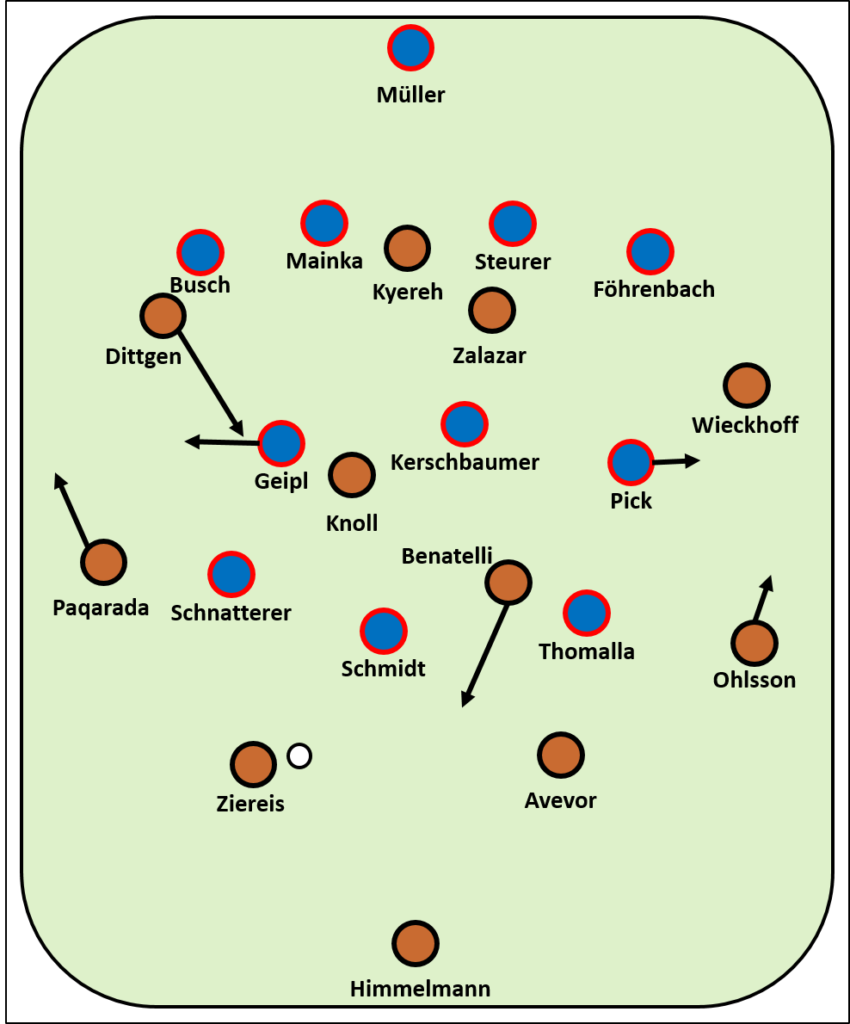
Ballgewinn, Standard, 2.Ball, Einwurf
Wie bereits eingangs erwähnt fielen die Tore dann jedoch nicht aus diesem geordneten Spielaufbau sondern aus allerlei anderen Situationen:
Beim 1-0 vergingen weniger als sieben Sekunden zwischen dem Moment als der Ball die Finger von Jonas Föhrenbach verließ und dem als er das Tornetz berührte. Durch konsequente Manndeckung hatte der FCSP den Ballgewinn nach Heidenheimer Einwurf erzwungen und mit dem ersten Torschuss die Führung erzielt.
Das 2-0 war ein Standard dessen Entstehung FCH-Trainer Frank Schmidt vermutlich besonders geärgert hat. Denn Fouls in der Nähe der Eckfahne sind ziemlich unnötig (weil von dort nur wenig Gefahr ausgeht) und bringen dem gegnerischen Team nur einen besseren Winkel für den Standard als eine Ecke.
Das 3-0 kann das als Lehrbucheintrag für eine Situation beim 2.Ball genutzt werden. Über das 4-0 müssen wir uns dann schon wieder genauer Gedanken machen. Oder wir genießen es einfach, denn es war auch schon in den vorherigen Spielen unter Timo Schultz auffällig, dass bei eigenen Einwürfen sehr viel mehr Planung vorhanden scheint als in all den Jahren zuvor. Ich persönlich denke jedenfalls, dass Marvin Knoll den Ball nicht unüberlegt nach vorne gefeuert hat (kann es aber aufgrund der Kamera-Einstellung nicht genau nachvollziehen).
Auf Umstellung folgt Dominanz (Spielaufbau Heidenheim 2. Halbzeit)
Richtig dominant wurde eines der beiden Teams erst, als das Spiel bereits ergebnistechnisch das Label „entschieden“ hätte bekommen können. Denn mit Beginn der zweiten Halbzeit, also nachdem Wieckhoff sehenswert das dritte FCSP-Tor erzielte, wurde eine Umstellung im Heidenheimer Aufbauspiel deutlich. Beide Außenverteidiger schoben nun nicht mehr komplett nach vorne. stattdessen war es meist Kerschbaumer der zentral vorrückte, während sein Kollege auf der Sechs, Andreas Geipl, im Spielaufbau auch gerne zwischen beide Innenverteidiger fiel.
Durch diese Umstellung gewann der 1. FC Heidenheim die offensiven Halbräume. Häufig waren es dann die von dort entweder einlaufenden Außenverteidiger die direkt flanken konnten oder aber es wurden Diagonalpässe auf die andere Seite geschlagen. Aber auch direkt über die Zentrale konnte Heidenheim Chancen entwickeln, welches ich vor allem den enorm starken Chrsitian Kühlwetter zuschreibe (wurde in der Halbzeit eingewechselt), der sich sehr geschickt zwischen Knoll/Benatelli und Avevor/Ziereis bewegte. Egal welcher Weg im Spielaufbau gewählt wurde, es führte dazu, dass Heidenheim zwischen der 55. und 70.Minute ganz klar das Spiel dominierte und sich in dieser Zeit einige hochkarätige Chancen herausspielte.
Gerade das Besetzen der Halbräume war aus meiner Sicht auch schon in der ersten Halbzeit gegen den VfL Bochum ein Problem bzw. Ausgangspunkt für einige Angriffe. Möglich, dass der FCSP hier bewusst Raum lässt, um ihn an anderer Stelle zu schließen. Doch wenn es dann nicht mehr gelingt (wie gestern gesehen) in günstige Umschaltmomente zu gelangen, dann wird das auf Dauer nicht funktionieren.
4-0 – Ein ganz gefährliches Ergebnis
Und was macht man am besten, wenn der Gegner einen einschnürt? Richtig, einfach mal das 4-0 erzielen und vermeintlich den Deckel raufsetzen. Mit dem 4. Tor in der 70.Minute schien das Spiel endgültig entschieden. Doch Ewald Lienen wird vermutlich beim Zuschauen die oben stehenden Worte gemurmelt haben und es war auch tatsächlich nur ganz kurz merklich, dass der FCH hier nicht mehr an ein Wunder glaubte.
Stattdessen führten zwei Heidenheimer Tore in der 78. und 80. Minute noch einmal für Spannung. Beide Tore fielen aufgrund von ausbaufähiger Abstimmung in der FCSP-Zentrale (hier ist Arbeit mit einzelnen Spielern nötig!). Doch während alle so etwas wie eine Schlussoffensive von Heidenheim erwarteten, lief einfach die Zeit runter und es passierte nichts mehr. Auch ungewohnt, da kennen wir den FCSP noch ganz anders, sehr viel zittriger.
Effizienz schlägt Ballbesitz
Es war also das bereits angekündigte intensive Spiel, bei dem es eher keine Verschnaufpause für beide Teams geben würde. Bemerkenswert sind hierbei die abgespulten Kilometer beider Teams (eigentlich halte ich nicht viel von diesen Daten, wenn die Sprints fehlen, aber dieses Mal sind sie erwähnenswert). Mit rund 125km (Daten vom kicker am Sonntagabend – da findet auch nochmal ne Korrektur statt) lief der FCSP zwar nur knapp mehr als Heidenheim (124km), aber eben erheblich mehr als alles anderen Zweitligisten, die bisher diesen Spieltag im Einsatz waren. Bemerkenswert.
Der FCSP gewinnt gegen den 1. FC Heidenheim also aufgrund einer enorm hohen Effizienz. Heidenheim-Torwart Kevin Müller hat vier Torschüsse auf das Tor bekommen, drei waren drin. Noch besser: Mit drei eigenen Torschüssen auf das Heidenheimer Tor führte der FCSP mit 4-0. Macht das mal nach.
Ich möchte das aber nicht schlechtschreiben hier, so ist es nämlich nicht gemeint. Denn gegen Heidenheim musst Du auch erstmal so agieren, dass diese sich erst in der 55.Minute die erste nennenswerte Chance herausspielen und vorher nicht vielmehr als als einen Fußball in für den FCSP ungefährlichen Zonen haben. Das spiegelt sich dann auch in der Qualtität der Torchancen nieder (xG-Werte bei 1.4 zu 1.1 für den FCSP). Klar, der 1. FC Heidenheim hatte mehr vom Spiel und war besonders nach der Umstellung in der 2. Halbzeit durchaus das tonangebende Team. Es ist aber auch die Frage, welche Zonen man als Team ganz bewusst hergibt, damit andere Bereiche des Spielfeldes vernünftig abgedeckt sind. Und das hat der FCSP in der ersten Halbzeit gegen ein gewohnt starkes Heidenheim sehr gut hinbekommen (abgesehen von der Cahnce in der 10.Minute durch Schnatterer). Erst in der 2. Halbzeit verlagerte sich das Spiel klar zugunsten der Heidenheimer. Da stand es jedoch schon 3-0…
Saisonstart geglückt nennt sich das dann wohl. Das freut mich riesig!
// Tim
Alle Beiträge beim MillernTon sind gratis. Wir freuen uns aber sehr, wenn Du uns unterstützt.
MillernTon auf BlueSky // Mastodon // Facebook // Instagram // Threads // WhatsApp // YouTube
{:}{:en}What a start into the season at home! It’s been a long time that the Millerntor did see four goals for the FCSP. The result, especially the 4-0 lead in between, might sound as this was a dominant matter. But it wasn’t. In fact, the FCSP can say thank you to its own efficiency. Nevertheless, there was again a lot of great things to witness on the pitch while there were also some construction sites remaining.
(This article does „only“ deal with football. all the other things can be found in Maik’s article.)
No Daschner, no Buballa, no backline of three.
In my pre-match article I expected Lukas Daschner and Daniel Buballa as members of the starting line-up. However, both were missing. Daniel Buballa had to take rain check due to a slight injury he acquired in the match against Bochum (this was at least what Timo Schultz announced in the post-match press conference). On the offensive half position, which I did assign to Lukas Daschner, surprisingly Rodrigo Zalazar made his appearance (who did not convince me on this position, which he doesn’t need to as he’s supposed to win matches instead, which he did…), while Benatelli and Knoll both played as central defensive midfielders.
While I was naming this formation as backline of three, I have to rectify myself and call the formation of the FCSP a classical 4-4-2 against the ball instead, however, still with some characteristics of a backline of five as Dittgen and Paqarada on the left were more often interpreting their role more offensive than Wieckhoff and Ohlsson on the other side.
Transition follows on transition, follows on transition, follows on transition…
I also mentioned in the pre-match article that both teams are playing vertically to the front as quick as possible whenever they gain the ball. Thereby, both teams willingly accepted that they might lose the ball as soon as it was gained. I took my time to watch the match re-live and I noted that the first shot on the goal which followed on the controlled built-up play of both teams happened in the 55th (!!!) minute only. Which also means that the other 10 shots on the goal from Heidenheim and the three goals of the FCSP before all resulted of other match situations (transition plays, second balls, set-pieces). This is, however, remarkable for a match in which both teams focused on their own transition play but it was due to the fact that both teams actually managed to disturb their respective opponent’s build-up play or that there’s still room for improvement for their own built-up. In general, from my perspective, it was the FCSP which played a better built-up, which, however, never resulted in a shot on the goal. So let’s have a more precise look at the built-up of both teams:
Built-up of the Heidenheim 1st half
The 1st FC Heidenheim definitely had more ball possession at the end of the match (almost 63%). This could indicate some sort of dominance in the match which actually was true for some time. However, for most of the time, this was just the result of the rather late beginning of the FCSP’s pressings.
Whenever Heidenheim was in ball possession, there was a bit of a change to their original 4-4-2 formation: The wing-backs (Föhrenbach on the left and the very strong Busch on the right) moved to the front. Both offensive midfielders Pick and Schnatterer then dropped more to the back (of course, Schnatterer was playing from the beginning although I announced that he rather played a subordinate role in Heidenheim recently, however, in general, his performance remained rather pale.). Additionally, Kerschbaumer left his position in the central midfield and positioned himself left to both central defenders so that a backline of three resulted for built-up (which actually allowed that both wing-backs could move to the front that far). The perfect version of Kerschbaumer’s positioning play was actually performed to its best by a certain Toni Kroos.
The FCSP defended with a 4-4-2 against this built-up. Thereby, Zalazar and Kyereh both marked central defender Geipl which resulted in him being taken out of the play effectively. The most complex roles had to be played by Dittgen and Wieckhoff, as they had to run against the dropping Pick and Schnatterer. Apart from that, the 4-4-2 of the FCSP resisted steadily against the built-up of Heidenheim. The FCH could only become very dangerous when they managed to free up Geipl in the centre to develop momentum. So for the whole first half, there was a lot of ball possession for Heidenheim, however, with only little earnings. This is probably why they changed their formation in the second half (I’ll pick up on that later).

Built-up FCSP
Despite a much higher pressing of Heidenheim, risking more than the FCSP itself, in general, the FCSP played a couraged flat built-up again. Thereby, Rico Benatelli was one of the initial players who sometimes even dropped between the two central defenders. The far movements of the wing-backs, which had been pivotal for the built-up of the pre-season, wasn’t used any longer. Instead, Dittgen and rarely even Wieckhoff were moving to the front line from where they only dropped back occasionally.
And again, the imbalance of the FCSP-play became obvious: While Jannes Wieckhoff was only rarely seen in the very front line and thus Ohlsson wasn’t moving any higher, too, Dittgen was doing exactly this more often so that Leart Paqarada could make use of the space in front of him. This lead to the fact that Paqarada and Wieckhoff acted on the same height although they were technically playing on different positions (which made me analyse a backline of three with wing-backs).
I already mentioned that I considered the built-up of the FCSP as a little bit better. This was first and foremost due to the fact that during the first half, the play was beautifully developed via the right flank. An in such situations it also became obvious why Wieckhoff wasn’t moving up that high: He still needed space in front of himself to make use of his speed. Already the first successful situation of the built-up play was thereby getting dangerous when Ohlsson (who is never playing strikingly but also barely making any mistakes and thus of enormous importance for the whole play of the FCSP) together with Kyereh („Play via the third“) managed to free up Wieckhoff on the right side.
The only question remaining is why they don’t play the same on the left where Dittgen is also a player with enormous speed. Instead, he moved to the very front line more often from where he dropped back to act as a wall player. Which is absolutely okay as Leart Paqarada feels a much stronger offensive urge than Seb Ohlsson on the opposite side. Additionally, with Marnon Busch there was a much more physical opponent on this site. Thus, it’s rather (very) likely that there will be much more initiated from the left side in future matches than yesterday.

Ball gain, set-piece, second ball, throw-in
But as already mentioned in the introduction, the goals of the match did not result from an ordered built-up but rather from different situations:
At the 1-0, it took less than seven seconds from the moment when the ball left the fingers of Jonas Föhrenbach until it reached the goal net. Through a consistent man-to-man-marking, the FCSP enforced the ball gain after a throw-in of Heidenheim and with their first shot on the goal they took the lead.
The 2-0 resulted from a set-piece which development must have outraged FCH-coach Frank Schmidt particularly. Because fouls close to the corner flag are pretty unnecessary (as there’s only little danger caused from there) and they offer the opponent team a much better angle for a set-piece than a corner ball.
The 3-0 can be seen as a textbook example for situations with the second ball. And the 4-0 has to be discussed on its own. Or we simply enjoy it as it again became obvious in matches under Timo Schultz that there seems to be much more of an idea about how to make use of own throw-ins than in the previous years. I personally think that Marvin Knoll did not just kick the ball to the front without any idea (however, due to the angle of the camera, I cannot confirm it entirely).
A change of formation caused dominance (Built-up of Heidenheim, second half)
However, one of the two teams became really dominant only after the match might have already received the label „result-wise decided“. Because shortly after Wieckhoff scored the third goal in a very notable manner, a change of the built-up of Heidenheim became obvious. Both wing-backs were no longer completely moving to the front. Instead, most of the time it was Kerschbaumer who moved up centrally while his central defensive midfielder, Andreas Geipl, dropped between the central defenders when building-up.
Through this change, the 1. FC Heidenheim won the offensive half-spaces. Often it was then either the wing-backs entering from there who could cross directly or diagonal passes were hit to the other side. But also through the centre, Heidenheim was able to elicit chances which I mostly assign to the tremendously strong Christian Kühlwetter (who was substituted in the second half) who was moving smartly between Knoll/Benatelli and Avevor/Ziereis. No matter which way was chosen for the built-up, it caused that Heidenheim was clearly dominating the match between the 55. and 70. minute and that they managed to create some very promising chances during this time.
Especially to cover the half-spaces was from my perspective already an issue during the first half against the VfL Bochum and a starting point for some attacks. It’s possible that the FCSP leaves this space deliberately here to close it at another point later. But if they do not manage to get into promising transition play moments (as happened yesterday) any longer, it will not work out in the long course.
4-0 – A really dangerous result
And what’s the best answer to an opponent constricting? Right, simply score the 4-0 to supposedly close the match. With the fourth goal in the 70th minute, the match appeared definitely decided. But Ewald Lienen did probably have mumbled the above-mentioned words and it was in fact actually only for a very short time detectable that the FCH was no longer believing in miracles.
Instead, two goals of Heidenheim in the 78th and 80th minute caused some more excitement. Both goals resulted due to improvable coordination of the FCSP centre (here’s definitely some work with certain individual players necessary). But while everyone was expecting a final offensive of Heidenheim now, the time simply passed by and nothing more was happening. This is again unfamiliar as we all know a completely different FCSP in such moments which used to be much more shivering.
Efficiency scores against ball possession
So it was the already announced intensive match in which there was almost no time to rest for any of both teams. Hereby, the running distances of both teams are outstandingly remarkable (usually, I do not care very much about this kind of data lacking sprints but this time, they are worth to be mentioned). With roughly 125km (data of kicker on Sunday evening, they’re usually adjusted later), the FCSP did, however, only barely run more than Heidenheim (124km) but remarkably more than all other clubs of the division which played until then on this matchday. Remarkable.
So, the FCSP wins against 1. FC Heidenheim because of enormously high efficiency. Heidenheim-goalie Kevin Müller did get four shots on his goal, three went in. even better: with three own shots on the goal the FCSP managed to create a 4-0 lead. Try to copy that.
I don’t want to write badly here, it’s not meant to be like that at all. Because first, you have to act against Heidenheim in a way that only allows them to create a worth mentioning chance in the 55th minute only and before that did only manage to play one ball into the dangerous space for the FCSP. This is also reflected in the quality of the goal chances (xG-values are 1.4 to 1.1 for FCSP). Of course, the 1st FC Heidenheim had more of the game and was especially after the change of formation in the second half the dominating team. But there is also the question of which zones are deliberately given away as a team so that other areas of the pitch are covered sensibly. And exactly that was managed pretty well by the FCSP against the strong-as-usual team of Heidenheim (besides the chance in the 10th minute of Schnatterer). Only in the 2nd half did the game clearly shift in favour of the Heidenheim team. But the result was already 3-0 then…
A successful start to the season is what we call that. And I am quite happy about that!
// Tim (Translated by Arne)
MillernTon Twitter //
MillernTon YouTube //
MillernTon Facebook //MillernTon Instagram //
If you like what we do here, here you’ll find the information on how to support us.
{:}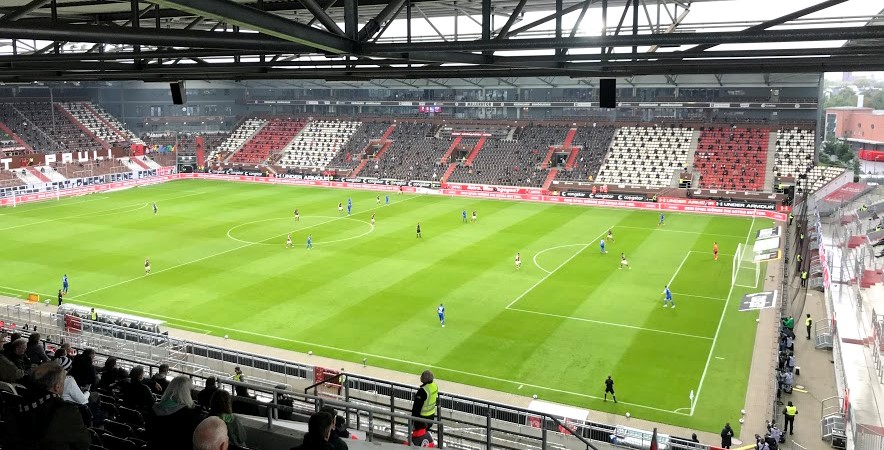

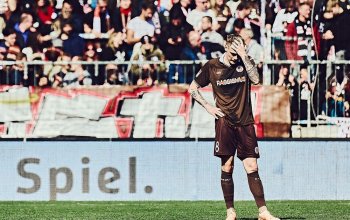
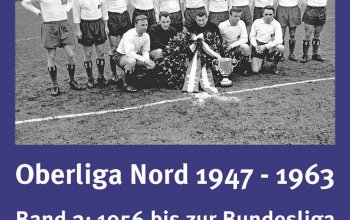

Danke Tim, für die wieder einmal sehr intensive Analyse. Der kann ich mich weitestgehend anschließen. Einzig, dass Du die Chance von Schnatterer in der 10. Minute unterschlägst. Wer weiß, wie dann das Spiel verlaufen wäre. Aber dafür haben wir ja einen TW, der besonders in den 1:1- Situationen glänzt. Walk on!
Au backe! Stimmt, die habe ich komplett unterschlagen…
sehr gute Taktik-Analyse!
Selbst die Heidenheim-Stürmer (Schmidt) haben ja gestern
für uns getroffen. Auch wenn man sich nach dem tollen 3-0 über
jede weitere Minute ohne Gegentor gefreut hat, weil das Pressing
des FCH danach schon heftig war. Nach dem 4-2 ahnte man irgendwie
noch kurz schlimmes. Die Zeit war aber gestern auf unserer Seite.
An so einem Sahnetag wie gestern hätte wohl auch Leo Manzi noch
sein Tor geschossen, wäre er noch aktiv.
Ja, nach dem 4-2 war kurz merklich, dass sich alle schütteln mussten. Ich fand es erstaunlich wie wenig danach noch passiert ist und das der FCSP das konzentriert verteidigt hat. Das kannte man sonst ganz anders…
Danke für die sehr gute und kurzweilige Analyse!
Du schreibst ja, dass zwischen der 55. und 70. Minute Heidenheim deutlich überlegender war. Den Eindruck hatte ich im Stadion auch und habe vorhin nochmal nachgeschaut: ab der 57. Minute hatte Heidenheim bereits alle fünf Wechsel durch – wir noch keinen. Gerade bei so einem laufintensiven Spiel vermute ich hier – trotz der beschriebenen taktischen Änderungen – einen Grund für die Überlegenheit in dem Zeitraum. Immerhin waren 50% der Feldspieler frisch(er) als die in Braun-Weiß. In der 69. Minute kamen dann Daschner und Aremu.
Ich hatte mich schon gestern nach dem Spiel gefragt, ob bei fünf Wechseloptionen bewusster als bei nur drei bereits früh frische Spieler gebracht werden sollten. Ich erwarte – im Gegensatz zu Testspielen in der Vorbereitung – dass dies auch nicht zu großen Brüchen im Spiel führen muss; die Spieler sind aufeinander und die Taktiksysteme eingespielt. Warum also nicht sogar konkret in ein Spiel gehen und ein, zwei Spielern die Aufgabe mitgeben, sich komplett auspowern und ab der Halbzeit gegen Spieler tauschen. Und dann immer noch drei Wechseloptionen zu haben.
Was meint Ihr?
Interessanter Ansatz – Ich habe ebenfalls schon darüber nachgedacht, dass es mit fünf Wechseloptionen wesentlich mehr Möglichkeiten, auch in Bezug auf die Umstellung der Systeme geben kann. Und ehrlichgesagt bin ich sicher, dass das bereits geschieht.
Kurze Ergänzung zu der Dominanzphase von Heidenheim. Nach dem 3:0 haben wir den Ball überlassen, zogen wir uns hinter die Mittellinie zurück und agierten in einem klassischen 4-3-3. Die Ketten waren wie an der Schnur gezogen sichtbar. Da griffen wir erst in der eigenen Hälfte an. Ich fand das auch sinnvoll, denn es war alles eine Frage der Kraft und unser Spiel war sehr laufintensiv. 125 km sind ein absoluter Spitzenwert. Solange Heidenheim langsam aufbaute, klappte das auch ordentlich. Sobald Heidenheim das Tempo auch nur ein wenig erhöhte, bekamen wir Probleme. Schon vor den Toren hatte Heidenheim, wie du das auch beschrieben hast, mehrere gute Chancen. Wir verlieren in solchen Phasen zu schnell die Ordnung in der Abwehr. Das war in Bochum auch schon so. Ich hoffe, dass wir in den nächsten Wochen auf keinen ähnlich effizienten Gegner treffen wie wir es gestern waren. Jedenfalls solange unser Defensivverbund entweder so mehr Sicherheit bekommt, oder (noch besser) wir Verstärkung(en) auf der IV-Position bekommen